WHAT IS A HEAT EXCHANGER? EVERYTHING YOU NEED TO KNOW
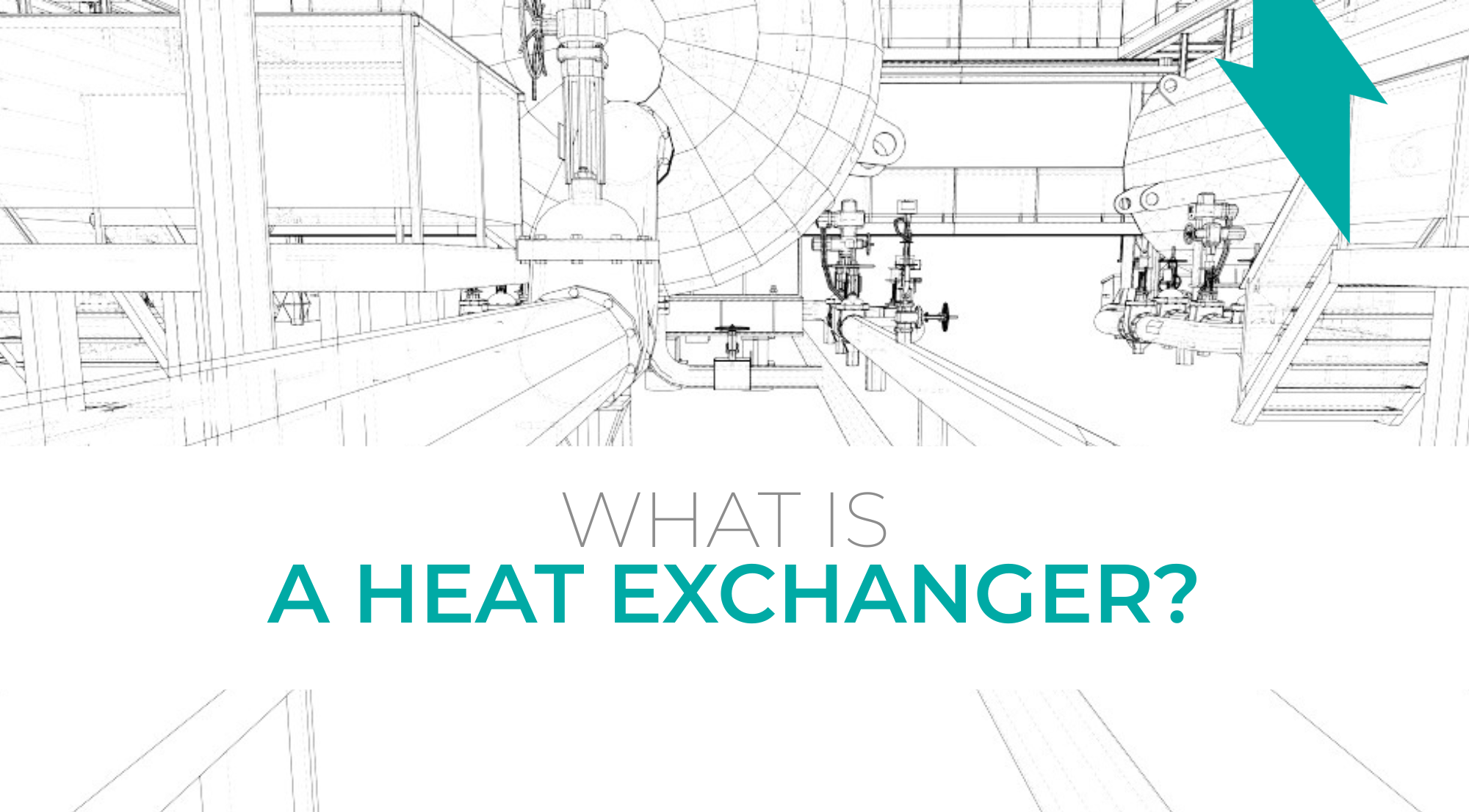


A heat exchanger is a system that enables controlled transfer of heat between two fluids, ensuring efficient cooling or heating. In most designs, the fluids are kept separate by solid barriers such as tubes or plates to prevent mixing, though some applications allow direct contact for rapid energy exchange.
From large-scale power plants to compact electronics, heat exchangers are everywhere. The radiator in an internal combustion engine uses circulating coolant flowing through tubes while air passes across to dissipate heat. In electronics, heat sinks channel excess heat away from critical components into air or liquid mediums. Across industries, the role remains the same driving efficiency, reliability and safety by ensuring that energy moves exactly where it is needed.
WORKING OF A HEAT EXCHANGER
Heat exchangers operate on a simple principle: heat moves from a hotter fluid to a cooler one through a conductive surface. One fluid enters hot, the other cold and they are either separated by a tube, plate or wall or directly contact each other (in special designs). Internal elements such as baffles, corrugations or fins increase turbulence, reduce fouling and maximize surface exposure. This controlled process ensures stable performance even in extreme operating conditions.
THERMODYNAMICS OF HEAT EXCHANGERS
The performance of heat exchangers is governed by the First Law of Thermodynamics energy conservation.
Q= U × A × ΔTlm
Where:
Q = Heat transfer rate
U = Overall heat transfer coefficient
A = Effective heat transfer area
ΔTlm = Log Mean Temperature Difference (average driving force for heat transfer)
This relationship ensures that the heat lost by the hot fluid is equal to the heat gained by the cold fluid. In complex cases, the effectiveness-NTU (Number of Transfer Units) method is also used to predict exchanger performance, particularly when inlet/outlet conditions vary.
CLASSIFICATION OF HEAT EXCHANGERS
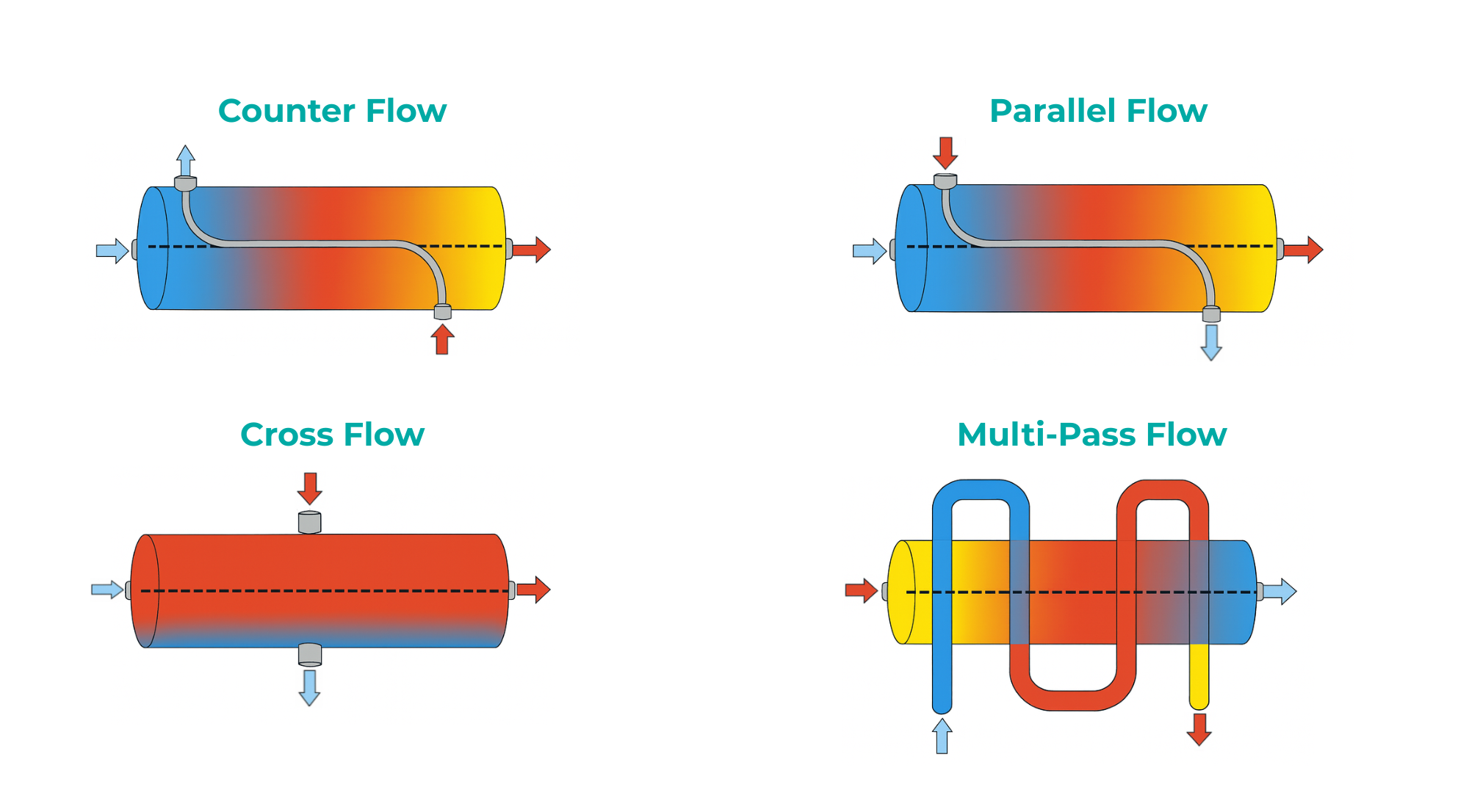
Heat exchangers may look very different from industry to industry, but engineers usually group them into two main categories: flow configuration and construction method.
Classification By Flow Configuration
This describes how the two fluids travel inside the exchanger:
- Counter Flow: In this arrangement, the two fluids move in opposite directions within the exchanger. As they travel, heat is exchanged along the entire length, with the temperature difference spread more evenly between the hot and cold streams.
- Parallel (Co-Current) Flow: Both fluids enter the exchanger from the same side and move in the same direction. This creates high heat transfer at the entry point, though the temperature difference reduces as the fluids progress through the exchanger.
- Cross Flow: The fluids travel at right angles to each other. A typical example is an automotive radiator, where coolant flows in one direction through tubes while air passes across them. This layout allows for compact design and effective cooling.
- Multi-Pass / Hybrid Flow: Some exchangers combine multiple passes or merge counter-flow and cross-flow patterns. This setup increases the length of heat transfer paths and helps achieve a balance between performance, equipment size and pressure drop
Classification By Construction
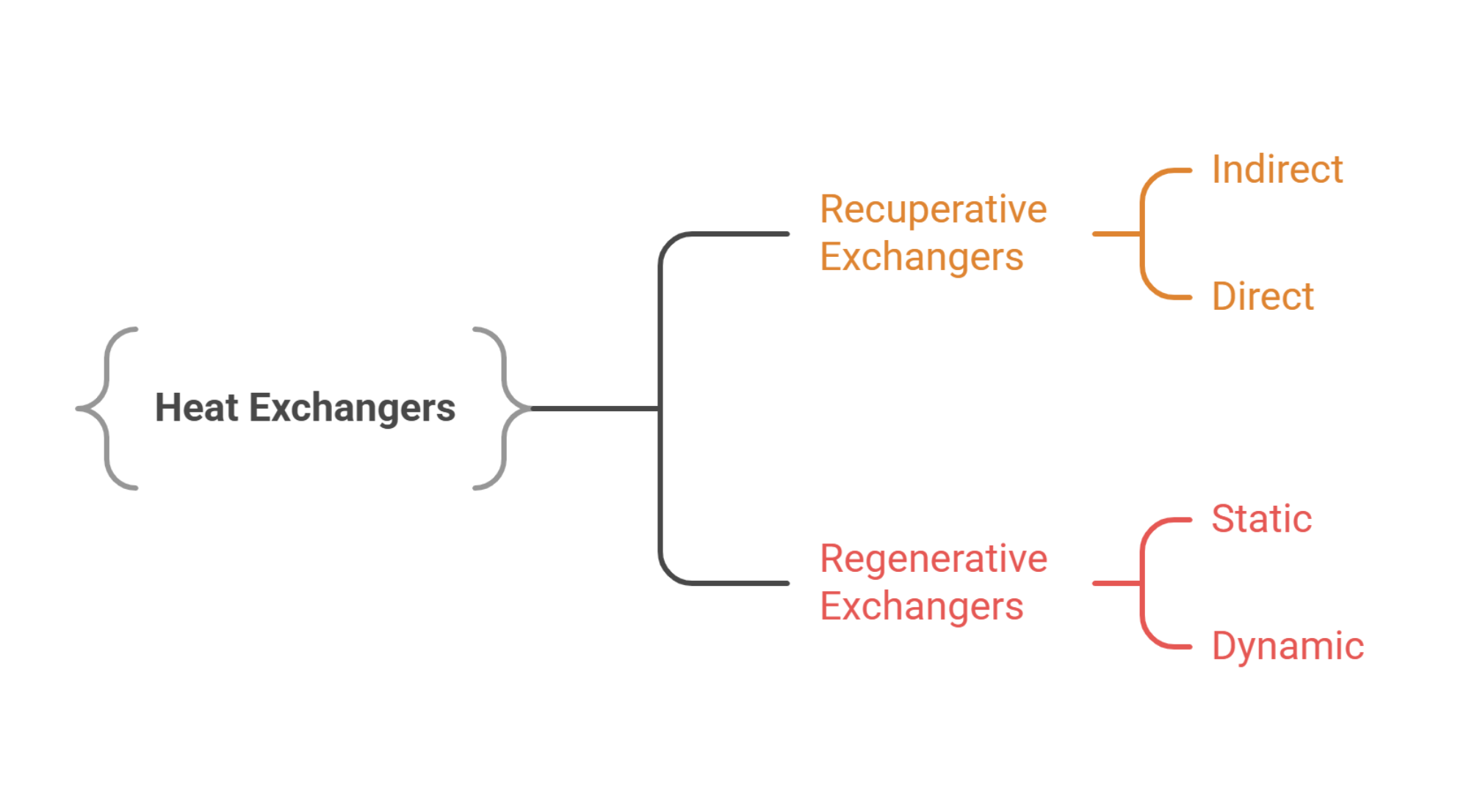
This describes the way a heat exchanger is physically built:
- Recuperative Exchangers: Hot and cold fluids are always separated by a wall (tube, plate or fin). Shell & tube exchangers and plate exchangers fall in this category. They are the most widely used.
- Regenerative Exchangers: A single surface alternately stores and releases heat first absorbing it from the hot fluid, then giving it to the cold fluid. They are often used in large power plants for energy recovery.
- Indirect Contact: Fluids never mix, staying on their own sides of a barrier. This is standard in industries where contamination must be avoided, such as food, pharma or aerospace.
- Direct Contact: Fluids actually touch each other, exchanging heat directly. Cooling towers and spray condensers are good examples. They are cheaper but limited to cases where fluids are immiscible or involve phase change.
TYPES OF HEAT EXCHANGERS
Heat exchangers come in a variety of designs, each tailored to specific operating conditions and industry needs. While their function remains the same transferring heat between two fluids the structure and application vary.
Shell & Tube Heat Exchanger:
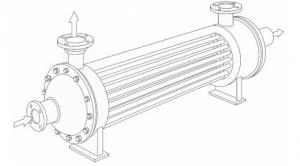
The shell-and-tube heat exchanger is the most widely used type in industries such as oil & gas, power generation and marine engineering. It consists of a cylindrical shell containing a bundle of tubes, with one fluid flowing through the tubes and another around them. These exchangers are highly versatile, capable of handling extreme pressures and temperatures.
How it works: One fluid flow inside the tubes while the other moves around them in the shell. Heat transfers through the tube walls. Baffles inside the shell guide the flow, create turbulence and enhance heat transfer efficiency.
Plate Heat Exchanger:

Compact and efficient, plate heat exchangers use a series of thin, corrugated plates stacked together to create multiple channels for fluids. They are widely used in HVAC systems, food processing and chemical industries where space-saving and easy maintenance are priorities.
How it works: Hot and cold fluids flow through alternating channels separated by plates. The corrugated surfaces increase turbulence, improving heat transfer. Gaskets or brazing keep the fluids sealed while the large plate area ensures rapid energy exchange.
Air-Cooled Heat Exchanger:
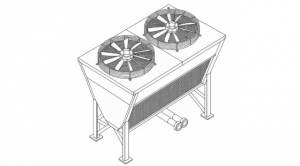
In locations where water is scarce or expensive, air-cooled exchangers are preferred. These systems use ambient air, circulated by fans, to cool fluids flowing through finned tubes. They are common in petrochemical plants, refineries and power stations where large-scale cooling is required without relying on water sources.
How it works: The process fluid flows inside finned tubes. Large fans push or pull air across the fins, which increase surface area and allow more heat to escape into the atmosphere. Depending on the setup, the design can be forced-draft (air pushed upward) or induced-draft (air drawn upward).
Double Pipe Heat Exchanger:
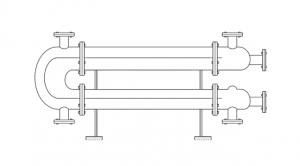
The double pipe heat exchanger is the simplest design, consisting of one pipe inside another. One fluid flow through the inner pipe while the other flows in the annular space between the pipes. While limited in capacity, these exchangers are economical and suitable for small-scale or pilot plant operations.
How it works: Heat moves through the wall of the inner pipe from the hotter fluid to the cooler fluid. The design can be arranged in parallel flow (both fluids move in the same directions), depending on the process requirements.
KEY COMPONENTS OF A HEAT EXCHANGER
A heat exchanger is far more than a simple device for thermal transfer, it is a carefully engineered system where every component plays a vital role. Each part is designed to withstand pressure, temperature changes and constant fluid flow, ensuring that heat moves efficiently between fluids while maintaining safety and long-term durability.
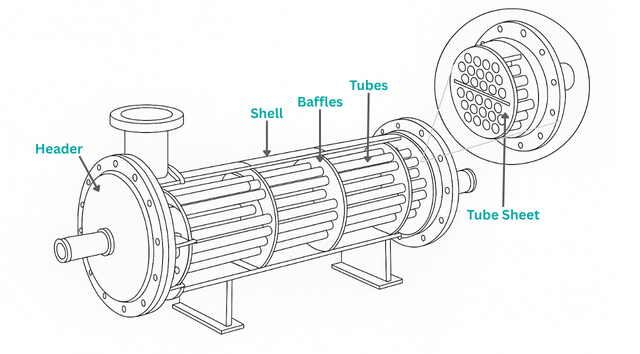
- Tube Sheet: The tube sheet is a thick, perforated plate that secures the ends of the tubes in exact alignment. It prevents mixing of shell-side and tube-side fluids while providing structural support. Its precision is critical because even the smallest deviation in hole spacing or surface finish can lead to leakage, vibration or premature failure of the exchanger.
- Shell: The shell forms the outer body of the exchanger and acts as the pressure vessel for the shell-side fluid. It encloses the tube bundle and ensures that fluid flows properly around the tubes. In large-scale applications, shells are designed to withstand extreme operating pressures and temperatures without deformation or leakage.
- Tubes: Tubes are the primary channels for heat transfer. They carry either the hot or cold fluid and are usually arranged in bundles to maximize surface area. Tube material selection is critical stainless steel, copper alloys, cupro nickel or super alloys are used depending on the environment. Tubes may be straight, U-shaped or finned to meet performance requirements.
- Baffles: Baffles are internal plates fixed inside the shell to guide fluid flow across the tube bundle. Instead of letting the shell-side fluid move straight through, baffles create turbulence that improves heat transfer efficiency. They also help support the tubes, minimizing vibration and mechanical stress during operation.
- Headers (or Channel Covers): Located at the ends of the exchanger, headers distribute fluid into the tubes and collect it after heat transfer. They are engineered to manage flow direction, pressure drop and sealing, ensuring the system functions smoothly.
APPLICATIONS OF HEAT EXCHANGERS:
Heat exchangers are not limited to a single sector they are integrated into almost every industry where heating, cooling or energy recovery is required. By ensuring stable temperatures and efficient energy transfer they silently support critical operations worldwide.
- HVAC Systems: In heating, ventilation and air conditioning (HVAC), heat exchangers form the backbone of systems such as air conditioners, chillers and condensers. They regulate indoor climates across residential, commercial and industrial buildings by transferring heat efficiently between air and refrigerants. With precision engineering these exchangers not only maintain comfort and air quality but also significantly reduce energy consumption making modern HVAC systems more sustainable and cost-effective
- Power Generation: From cooling massive steam turbines to managing boiler operations, heat exchangers are indispensable in power plants. They ensure stable temperature control, enhance thermal efficiency and protect equipment from overheating under high load conditions. Whether in nuclear, thermal or renewable energy setups, these systems optimize energy transfer while safeguarding plant reliability.
- Marine Applications: Ships, offshore rigs and marine engines rely heavily on heat exchangers to regulate temperatures in cooling water, lubricants and fuel systems. Operating in harsh sea environments, these exchangers are engineered to withstand corrosion from saline conditions while delivering consistent thermal performance to keep propulsion and auxiliary systems running smoothly.
- Aerospace & Defense: In aerospace, heat exchangers are precision-built to handle extreme pressure, vibration and fluctuating temperatures. They play a critical role in cooling aircraft engines, avionics and hydraulic systems, where reliability and weight optimization are paramount. Advanced materials and tight tolerance manufacturing ensure maximum efficiency and safety in mission-critical conditions.
- Process Industries: In chemical, petrochemical and pharmaceutical sectors, heat exchangers enable precise temperature regulation during manufacturing processes. They facilitate reactions, distillations and cooling operations where even minor thermal deviations can impact product quality. Designed for demanding environments, these exchangers deliver performance, durability and process consistency.
WHY SCHILTHORN PRECISION FOR YOUR HEAT EXCHANGER NEEDS?
At Schilthorn Precision Engineering, we bring over 18+ years of proven expertise in manufacturing high-precision heat exchanger components. Our world-class facility, backed by ISO 9001 and AS9100 certifications, ensures that every product meets the toughest international standards and client specifications, from tube sheets & shells tubes to custom assemblies, our components are built to deliver reliability, performance and cost efficiency across industries. Connect with us today to discuss your custom heat exchanger requirements and experience how precision engineering drives better value.
